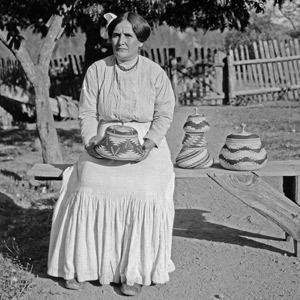Died 19 July 1947 | ||
 | ||
Elizabeth Conrad Hickox (1872- July 19, 1947) was a Wiyot master basket weaver and was considered one of the finest basket-weavers of her time. Her baskets differ from other Lower Klamath baskets through her own unique use of shape, technique, color scheme and design. Her work is in the collections of the National Museum of the American Indian, the Lauren Rogers Museum of Art, Harvard's Peabody Museum, the University of Pennsylvania Museum, the Field Museum of Natural History, the Southwest Museum of Los Angeles, the Denver Art Museum and the Los Angeles County Museum of Natural History.
Contents
Biography
Hickox's mother was Wiyot and her father, European-American. It was reported that Hickox's mother, Polly, had been abducted by her later husband, Charles Conrad. When Elizabeth was in her teens, she married Frank Merrill, a part-Karuk man, and they had two children together, Jessie and Bruce. She later married Luther Hickox in 1895. Luther Hickox owned a gold mine, was a part owner of a sawmill and later became a justice of the peace. The couple enjoyed a high social status among the Karuk people, as well as financial security.
When Hickox was alive she lived along the Salmon River in Northern California.
Hickox died on July 19, 1947.
Work
Hickox used various materials to weave her baskets including grape root twining, white bear grass (Xerophyllum tenax), dyed wooodwardia fern, black maidenhair fern and dyed porcupine quills. She tended to use the fern Adiantum aleuticum, a dark material in contrast to the quills of the porcupine dyed yellow with Letharia vulpina. The choice to mostly use dark materials contrasted with the yellow was her own choice, and not subject to marketplace demands. She made about five baskets a year between 1911 and 1934.
Hickox and her daughter, Louise, weaved and sold their baskets to Grace Nicholson, who continued to buy their work even during the Great Depression. Though Hickox was Wiyot, Nicholson marketed her baskets as "Karuk" because they lived in the Karuk area. Before Hickox met Nicholson, she had already chosen to create fine-art baskets. After Nicholson stopped purchasing baskets in 1934, Hickox continued to weave "for pleasure, utility and gift-giving."
